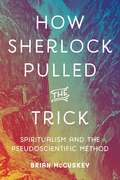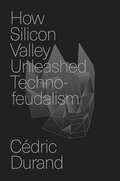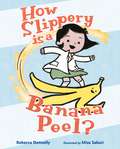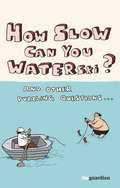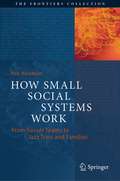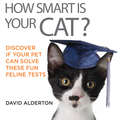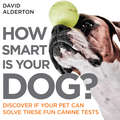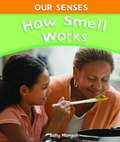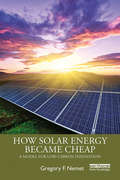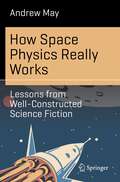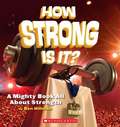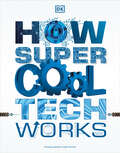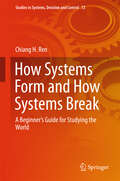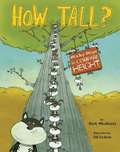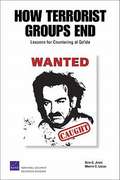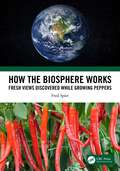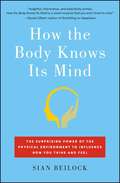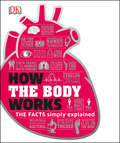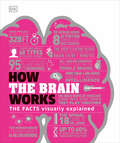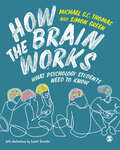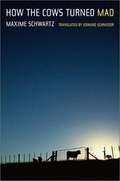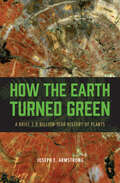- Table View
- List View
How Sherlock Pulled the Trick: Spiritualism and the Pseudoscientific Method
by Brian McCuskeyA masterful combination of literary study and author biography, How Sherlock Pulled the Trick guides us through the parallel careers of two inseparable men: Sherlock Holmes and his creator, Sir Arthur Conan Doyle. Reconsidering Holmes in light of Doyle’s well-known belief in Victorian spiritualism, Brian McCuskey argues that the so-called scientific detective follows the same circular logic, along the same trail of questionable evidence, that led Doyle to the séance room.Holmes’s first case, A Study in Scarlet, was published in 1887, when natural scientists and religious apologists were hotly debating their differences in the London press. In this environment, Doyle became convinced that spiritualism, as a universal faith based on material evidence, resolved the conflict between science and religion. The character of Holmes, with his infallible logic, was Doyle’s good faith solution to the cultural conflicts of his day. Yet this solution has evolved into a new problem. Sherlock Holmes now authorizes the pseudoscience that corrupts our public sphere, defying logic, revising history, and promoting conspiracy theories. As this book demonstrates, wearing a deerstalker does not make you a mastermind—more likely, it marks you as a crackpot.Fascinating and highly readable, How Sherlock Pulled the Trick returns the iconic Holmes to his mystical origins.
How Silicon Valley Unleashed Techno-Feudalism: The Making of the Digital Economy
by Cédric DurandThe promise of the New Economy gone, we have regressed into the age of techno-feudalismThe rise of the IT industry in the nineties promised a new era of freedom and prosperity. It didn&’t deliver. Certainly, algorithms are everywhere, but capitalism is no more civilised than ever.In fact, in the hands of private corporations, the digitalisation of the world drives us towards a darker future. The return of monopolies, the dominance of a few platforms, the blurred distinction between the economic and the political all epitomise a systemic mutation. Information and data networks push the digital economy in the direction of the feudal logic of rent, dispossession, and personal domination.How Silicon Valley Unleashed Techno-feudalism offers a fresh genealogy of the Silicon Valley consensus and its contradictions. It disentangles the principles of an emerging systemwide rationale. Large firms compete in cyberspace to gain control over data, and ordinary people are increasingly at the mercy of tech giants. In this new economic order, capital is moving away from production to focus on predation.
How Slippery Is a Banana Peel?
by Rebecca DonnellyRebecca Donnelly's How Slippery Is a Banana Peel? is a picture book companion to Cats Are a Liquid celebrating the science and the slipperiness of banana peels—a perfect introduction to friction, featuring illustrations by Misa Saburi.Volcanoes roar,But banana peels race.Rockets soar,Like bananas through space.A group of kid-experimenters at a science fair explore the slipperiness of banana peels—a perfect introduction to scientific concepts! It's funny and STEM-inspired, with back matter on friction and a kitchen science experiment. These playful and mischievous banana peels will capture the imagination of readers.
How Slow Can you Waterski?: and other puzzling questions ...
by Guardian News and Media LtdWhen the powers that be reduced the speed limit on Lake Windermere to 10 knots, waterskiers complained that their sport was now completely scuppered. So just how slow can you waterski before you start to sink beneath the waves?And, while we're about it, how long can you survive in a freezer? What are the chances of being struck by lightning in bed? And why is it so esay to raed wrods eevn wehn the lteetrs are mdduled up?Everyday life can pose some mind-boggling questions - but where do you find the answers? The Guardian's popular 'This Week' column has been looking into the science behind the news for three years, and How Slow Can You Waterski? draws together a selection of the most imaginative questions and the most surprising answers. If you've ever wondered what makes a planet a planet, why submarines keep bumping into things or even if it's safe to eat mud, How Slow Can You Waterski? will prove irresistible - and enlightening - reading.
How Small Social Systems Work: From Soccer Teams to Jazz Trios and Families (The Frontiers Collection)
by Yair NeumanMost of us are intuitively familiar with small social systems, such as families and soccer teams. Surprisingly, though, most of us are unaware of how complex these systems are or of the fact that they have a unique character distinguishing them from both populations and individuals. The current manuscript, which emerged from high-level scientific publications on the subject, aims to bridge this gap in our understanding of small social systems. The book aims to explain, illustrate, and model the unique and fascinating nature of small (social) systems by relying on deep scientific foundations and by using examples from sport, movies, music, and the martial arts. To support its friendly exposition of challenging scientific ideas, the book also discusses entertaining questions such as (1) why inviting your mother-in-law to dinner might be a challenging event, for reasons you have never considered; (2) why soccer teams should be messy in order to win; (3) why Nazis are deeply wrong in their understanding of the importance of entropy; and (4) why “panda fighters” failed in the UFC (Ultimate Fighting Championship)."How Small Systems Work is a welcome book, which sheds light on a branch of mathematics overlooked by scholars: how networks store information. Focusing on small systems, the book asks fundamental questions, providing the tools (and the examples) for answering them –with fun. Neuman analyses, with plenty of humor, the dynamics of a family of cats, the pleasure of listening to jazz, and the science behind football championships, while uncovering hidden gems in the history of cinema”Dr. Mario Alemi, author of “The Amazing Journey of Reason: from DNA to Artificial Intelligence”
How Smart Is Your Cat?
by David AldertonWe all wonder how much our pet understands, what is going on in their head and just how intelligent they really are. This entertaining and comprehensive guide will not only explain your cat's sometimes baffling behavior--it will give you the means to test your pet's IQ yourself.Using your cat's natural skills, How Smart Is Your Cat? will enable you to improve their responses and reactions--and ultimately their IQ--as you work through a wealth of intelligence tests, giving them a star rating as they progress. The bond between you will deepen as you learn more about how your cat thinks.Featuring panels on feline psychology, different cat breeds and information on how cats communicate, How Smart Is Your Cat? is the ideal companion for everyone who wants to understand what their cat is thinking and how to communicate with them effectively.The perfect gift for cat lovers everywhere, this book will open your eyes to just how canny your kitten can be!
How Smart Is Your Dog?
by David AldertonPacked with a wealth of fun tests and easy-to-teach exercises, this comprehensive guide will allow you to test your dog's IQ, communicate with them more effectively and teach them tricks that will impress your friends and family.Using your dog's natural skills, How Smart Is Your Dog? will enable you to teach them tricks like 'shake hands', 'fetch a ball', 'play dead' and 'salute'. A star rating system enables you to assess your pet's IQ as they progress through the tests and tricks. The bond between you will deepen as your dog learns to respond to your instructions and enjoys the reward that awaits them at the end.Featuring panels on canine psychology, different dog breeds, information on how animals learn and the best way to teach them, How Smart Is Your Dog? is the ideal companion to your training. From basic obedience skills for your puppy to advanced agility routines, your pet will have fun learning--and hopefully you will too.The perfect gift for dog lovers everywhere, this book will open your eyes to just how smart your pooch can be!
How Smell Works (Our Senses)
by Sally MorganWhy do some things smell good and other things smell bad? This book explains where our sense of smell comes from and how it helps us function in everyday life. A lively, straightforward narrative presents scientific concepts for young readers and an activity is included enhance the learning experience.
How Societies Remember
by Paul ConnertonIn treating memory as a cultural rather than an individual faculty, this book provides an account of how bodily practices are transmitted in, and as, traditions. Most studies of memory as a cultural faculty focus on written, or inscribed transmissions of memories. Paul Connerton, on the other hand, concentrates on bodily (or incorporated) practices, and so questions the currently dominant idea that literary texts may be taken as a metaphor for social practices generally. The author argues that images of the past and recollected knowledge of the past are conveyed and sustained by ritual performances and that performative memory is bodily. Bodily social memory is an essential aspect of social memory, but it is an aspect which has until now been badly neglected. An innovative study, this work should be of interest to researchers into social, political and anthropological thought as well as to graduate and undergraduate students.
How Solar Energy Became Cheap: A Model for Low-Carbon Innovation
by Gregory F. NemetSolar energy is a substantial global industry, one that has generated trade disputes among superpowers, threatened the solvency of large energy companies, and prompted serious reconsideration of electric utility regulation rooted in the 1930s. One of the biggest payoffs from solar’s success is not the clean inexpensive electricity it can produce, but the lessons it provides for innovation in other technologies needed to address climate change. Despite the large literature on solar, including analyses of increasingly detailed datasets, the question as to how solar became inexpensive and why it took so long still remains unanswered. Drawing on developments in the US, Japan, Germany, Australia, and China, this book provides a truly comprehensive and international explanation for how solar has become inexpensive. Understanding the reasons for solar’s success enables us to take full advantage of solar’s potential. It can also teach us how to support other low-carbon technologies with analogous properties, including small modular nuclear reactors and direct air capture. However, the urgency of addressing climate change means that a key challenge in applying the solar model is in finding ways to speed up innovation. Offering suggestions and policy recommendations for accelerated innovation is another key contribution of this book. This book will be of great interest to students and scholars of energy technology and innovation, climate change and energy analysis and policy, as well as practitioners and policymakers working in the existing and emerging energy industries.
How Space Physics Really Works: Lessons from Well-Constructed Science Fiction (Science and Fiction)
by Andrew MayThere is a huge gulf between the real physics of space travel and the way it is commonly portrayed in movies and TV shows. That’s not because space physics is difficult or obscure – most of the details were understood by the end of the 18th century – but because it can often be bafflingly counter-intuitive for a general audience. The purpose of this book isn’t to criticize or debunk popular sci-fi depictions, which can be very entertaining, but to focus on how space physics really works. This is done with the aid of numerous practical illustrations taken from the works of serious science fiction authors – from Jules Verne and Arthur C. Clarke to Larry Niven and Andy Weir – who have taken positive pleasure in getting their scientific facts right.
How Space Works: The Facts Visually Explained (DK How Stuff Works)
by DKEmbark on an awe-inspiring and informative journey through our Solar System and beyond in this illuminating astronomy book! Discover how big the Universe is, why our view of the sky is constantly changing, what came before the Big Bang, and so much more in 3... 2... 1…. Blast Off! Inside the pages of this comprehensive guide to astronomy for beginners, you&’ll discover: • Simple text and step-by-step graphics that make astronomy easy to understand • Fun facts and tip-of-the-tongue questions are presented through bite-sized factoids and question-and-answer features • Clear explanations demystifying more advanced topics such as cosmic rays, dark matter, and black hole collisions Take a peek at what lies beyond the stratosphereThis out-of-this-world reference book about space introduces you to the weird and wonderful discipline of astronomy and space exploration. From the structure of the Milky Way to the Earth&’s nearest celestial body, the Moon, How Space Works takes you on an unforgettable tour through the stars and galaxies, and to the furthest reaches of space!Answering all your burning questions about space, from ancient white dwarf stars to the Mars Rover, this visual guide explains the essentials of astronomy through bold graphics and step-by-step artworks. It&’s the ultimate book for armchair astronomers and space-technology enthusiasts looking for reliable and up-to-date facts and explanations.Don&’t let the learning stop - try the rest of the series!DK's How Things Work series uses dynamic graphics and jargon-free text to explain the modern world simply and clearly. Packed with fascinating facts and stats, these visual guides cover everything from science to philosophy, making complex topics more accessible than ever before!
How Strong Is It?: A Mighty Book All About Strength
by Ben HillmanHOW STRONG IS IT? A Mighty Book All About Strength. How strong is a spiderweb? Spider silk is one of the most amazing materials found on the planet--natural or human-made. In fact, if each strand was as thick as a pencil, a spiderweb could stop a Boeing 747 in mid-flight!
How Super Cool Tech Works
by DKDiscover the mind-blowing high-tech inventions of the future! Incredible images reveal the secret inner workings of everything from drones and supercomputers to underwater hotels and flying cars.How Super Cool Tech Works explains how incredible technologies will shape the world of tomorrow. Explore robotics, space rockets, artificial intelligence, and even game consoles in this cutting-edge non-fiction science book for kids aged 9 and over. Also featured are state-of-the-art buildings, new ways of traveling, imaginative entertainment gadgets, and even how teleportation and invisibility cloaks might be possible in the future. Each exciting subject is explained in detail, via crisp images and engaging, child-friendly text. "How it works" panels explain each subject&’s secret inner workings.New and updated for 2020, How Super Cool Tech Works is a one-stop shop for kids who want to know what the latest and greatest technologies are, and how they will shape our world in the years to come.
How Systems Form and How Systems Break
by Chiang H. RenOur world is composed of systems within systems the machines we build, the information we share, the organizations we form, and elements of nature that surround us. Therefore, nearly every field of study and practice embodies behaviors stemming from system dynamics. Yet the study of systems has remained somewhat fragmented based on philosophies, methodologies, and intentions. Many methodologies for analyzing complex systems extend far beyond the traditional framework of deduction evaluation and may, thus, appear mysterious to the uninitiated. This book seeks to dispel the mysteries of systems analysis by holistically explaining the philosophies, methodologies, and intentions in the context of understanding how all types of systems in our world form and how these systems break. This presentation is made at the level of conceptual understanding, with plenty of figures but no mathematical formulas, for the beginning student and interested readers new to studying systems. Through the conceptual understanding provided, students are given a powerful capability to see the hidden behaviors and unexplained consequences in the world around us. "
How Tall?: Wacky Ways To Compare Height (Wacky Comparisons)
by Mark Weakland Advocate-Art Staff Terry Flaherty Igor SinkovecHow many chipmunks equals the height of a redwood tree? Discover this comparison and more in this wacky, laugh-out-loud introduction to height. Quirky illustrations and lyrical text help kids explore measureable attributes of a variety of things in a uniquely engaging way. A perfect read-aloud for young science lovers and budding mathematicians.
How Terrorist Groups End: Lessons for Countering Al Qa'ida
by Martin C. Libicki Seth G. JonesAll terrorist groups eventually end. But how do they end? The evidence since 1968 indicates that most groups have ended because (1) they joined the political process (43 percent) or (2) local police and intelligence agencies arrested or killed key members (40 percent). Military force has rarely been the primary reason for the end of terrorist groups, and few groups within this time frame have achieved victory. This has significant implications for dealing with al Qa'ida and suggests fundamentally rethinking post-9/11 U.S. counterterrorism strategy: Policymakers need to understand where to prioritize their efforts with limited resources and attention. The authors report that religious terrorist groups take longer to eliminate than other groups and rarely achieve their objectives. The largest groups achieve their goals more often and last longer than the smallest ones do. Finally, groups from upper-income countries are more likely to be left-wing or nationalist and less likely to have religion as their motivation. The authors conclude that policing and intelligence, rather than military force, should form the backbone of U.S. efforts against al Qa'ida. And U.S. policymakers should end the use of the phrase 'war on terrorism' since there is no battlefield solution to defeating al Qa'ida.
How the Biosphere Works: Fresh Views Discovered While Growing Peppers
by Fred SpierHow the Biosphere Works: Fresh Views Discovered While Growing Peppers offers a simple and novel theoretical approach to understanding the history of the biosphere, including humanity’s place within it. It also helps to clarify what the possibilities and limitations are for future action. This is a subject of wide interest because today we are facing a great many environmental issues, many of which may appear unconnected. Yet all these issues are part of our biosphere. For making plans for the future and addressing our long-term survival and well-being, an integrated knowledge of our biosphere and its history is therefore indispensable. Key Features Documents what the biosphere is, and what our position as humans within it is today. Describes how the biosphere has become the way it is. Summarizes the novel simple theoretical model proposed in the book, and thus, how the biosphere functions. Predicts what the possibilities and limitations are for future human action Emphasizes how simple but careful observations can lead to far-reaching theoretical implications.
How the Body Knows Its Mind: The Surprising Power of the Physical Environment to Influence How You Think and Feel
by Sian BeilockAn award-winning scientist offers a groundbreaking new understanding of the mind-body connection and its profound impact on everything from advertising to romance.The human body is not just a passive device carrying out messages sent by the brain, but rather an integral part of how we think and make decisions. In her groundbreaking new book, Sian Beilock, author of the highly acclaimed Choke, which Time magazine praised for its "smart tips...in order to think clearly...and be cool under pressure," draws on her own cutting-edge research to turn the conventional understanding of the mind upside down in ways that will revolutionize how we live our lives. At the heart of How the Body Knows Its Mind is the tantalizing idea that our bodies "hack" our brains. The way we move affects our thoughts, our decisions, and even our preferences for particular products. Called "embodied cognition," this new science--of which Beilock is a foremost researcher--illuminates the power of the body and its physical surroundings to shape how we think, feel, and behave. Beilock's findings are as varied as they are surprising. For example, pacing around the room can enhance creativity; gesturing during a speech can help ensure that you don't draw a blank; kids learn better when their bodies are part of the learning process; walking in nature boosts concentration skills; Botox users experience less depression; and much more. From the tricks used by advertisers to the ways body language can improve your memory, Beilock explains a wealth of fascinating interconnections between mind and body and how mastering them can make us happier, safer, and more successful.
How the Body Works: The Facts Simply Explained (DK How Stuff Works)
by DKThis book takes you on the ultimate anatomical adventure around your own body, revealing how little you know about yourself in mind-blowing depth and detail.As part of the best-selling How Things Work series, this biological bonanza uses dynamic graphics, simple science, and accessible text to explore and explain this tricky subject as never before. If you&’ve ever wondered why your blood is red, how your reflexes work, what makes you feel dizzy, and where exactly are the butterflies in your tummy, then wonder no more. The answers to all these questions and many others are included in this essential visual guide. From body basics to advanced anatomy, How the Body Works introduces all your weird and wonderful parts and processes, alongside fascinating facts and easy explanations across hundreds of pages. Guaranteed to get your brain in gear, you&’ll get to know your physical self in terms of cells, skin, bones, and blood, as well as getting to grips with your emotional side in the psychology of emotions, memories, and dreams. Understand how our bodies keep us alive and thriving with How the Body Works.
How the Brain Works: The Facts Visually Explained (DK How Stuff Works)
by DKAre men's and women's brains really different? Why are teenagers impulsive and rebellious? And will it soon be possible to link our brains together via the Cloud?Drawing on the latest neuroscience research, this visual guide makes the hidden workings of the human brain simple to understand. How the Brain Works begins with an introduction to the brain's anatomy, showing you how to tell your motor cortex from your mirror neurons. Moving on to function, it explains how the brain works constantly and unnoticed to regulate heartbeat and breathing, and how it collects information to produce the experiences of sight, sound, smell, taste, and touch. The chapters that follow cover memory and learning, consciousness and personality, and emotions and communication.There's also a guide to the brain's disorders, including physical problems, such as tumors and strokes, and psychological and functional disorders, ranging from autism to schizophrenia. Illustrated with bold graphics and step-by-step artworks, and sprinkled with bite-sized factoids and question-and-answer features, this is the perfect introduction to the fascinating world of the human brain.
How the Brain Works: What Psychology Students Need to Know
by Michael S. Thomas Simon GreenDelve into the intricacies of the human mind with this engaging and insightful guide to how the brain works. Written in a playful style and beautifully illustrated, this book is designed to support you as you embark on the beginning of your psychology degree. It provides an accessible guide to how the brain’s structures and functions determine how the mind works, and how this fits into the bigger picture of our evolution and biology as a species. From focus boxes that delve into specific topics to entertaining puzzles that bring the subject to life, this book will captivate your imagination while building your understanding of biological and cognitive psychology. This is an essential read for undergraduate psychology students. Michael S.C. Thomas is Professor of Cognitive Neuroscience at Birkbeck, University of London. Simon Green is a Chartered Psychologist and retired Senior Lecturer in Psychology at Birkbeck, University of London.
How the Brain Works: What Psychology Students Need to Know
by Michael S. Thomas Simon GreenDelve into the intricacies of the human mind with this engaging and insightful guide to how the brain works. Written in a playful style and beautifully illustrated, this book is designed to support you as you embark on the beginning of your psychology degree. It provides an accessible guide to how the brain’s structures and functions determine how the mind works, and how this fits into the bigger picture of our evolution and biology as a species. From focus boxes that delve into specific topics to entertaining puzzles that bring the subject to life, this book will captivate your imagination while building your understanding of biological and cognitive psychology. This is an essential read for undergraduate psychology students. Michael S.C. Thomas is Professor of Cognitive Neuroscience at Birkbeck, University of London. Simon Green is a Chartered Psychologist and retired Senior Lecturer in Psychology at Birkbeck, University of London.
How the Cows Turned Mad
by Maxime Schwartz Edward SchneiderThis scientific thriller, available in English for the first time and updated with a new chapter on developments in 2001, tells of the hunt for the cause of an enigmatic class of fatal brain infections, of which mad cow disease is the latest incarnation.
How the Earth Turned Green: A Brief 3.8-Billion-Year History of Plants
by Joseph E. ArmstrongThis &“amazing and wonderful book&” explores the evolutionary history of photosynthesis in a grand story of how the world became the verdant place we know (Choice). On this blue planet, long before dinosaurs reigned, tiny green organisms populated the ancient oceans. Fossil and phylogenetic evidence suggests that chlorophyll, the green pigment responsible for coloring these organisms, has been in existence for some 85% of Earth&’s long history—that is, for roughly 3.5 billion years. In How the Earth Turned Green, Joseph E. Armstrong traces the history of these verdant organisms, which many would call plants, from their ancient beginnings to the diversity of green life that inhabits the Earth today. Using an evolutionary framework, How the Earth Turned Green addresses questions such as: Should all green organisms be considered plants? Why do these organisms look the way they do? How are they related to one another and to other chlorophyll-free organisms? How do they reproduce? How have they changed and diversified over time? And how has the presence of green organisms changed the Earth&’s ecosystems? With engaging prose and astonishing breadth, as well as informative diagrams and illustrations, How the Earth Turned Green demonstrates &“how the Earth blossomed into such an incredible world that most of us simply take for granted&” (San Francisco Book Review).
